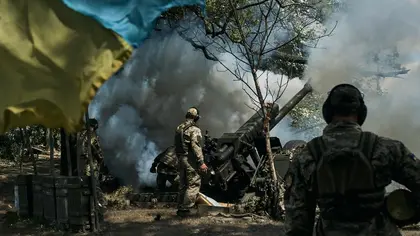LATEST: Ukraine Counter-Offensive Update for June 15: ‘A Very Serious Confrontation’
Ukrainian forces captured the village of Urozhaine in the boundary area between the Zaporizhzhia and Donetsk regions, which brings the total number of deoccupied villages during Ukraine’s summer offensive to eight.
The gain means that the summer offensive has recovered some 100 square kilometers (39 square miles) of Ukrainian territory from Russian occupation forces – a figure also given yesterday by Wagner boss Yevgeny Prigozhin.
However, the offensive continues to take the form of probes by Ukrainian forces rather than major movements of large-scale mechanized infantry units at the brigade level.
In the area near the administrative border between the Zaporizhzhia and Donetsk regions, Ukraine’s Deputy Defense Minister Hanna Maliar said that Ukrainian forces advanced from between 500 to 1,000 meters in the area around the TO518 farm road and Mokri Yaly River and “liberated” around three square kilometers of territory, including Urozhaine.
In the vicinity, Ukrainian forces were reported as clearing local minefields and preparing to enter Novopil and Rivnopil. Blue asterisks below mark confirmed Ukrainian deoccupation in this theater.
There were reports of unsuccessful Russian counterattacks on Makarivka, but Ukrainian spokespeople assert the village is still in Ukrainian hands.
Russian forces were reported to also have blown two dams on the Mokri Yaly River to impede Ukrainian progress. Ukrainian Ministry of Defense representative Major Vladyslav Dudar said Russian forces are regularly destroying small dams in localized areas of southern Ukraine to disrupt Ukrainian counteroffensive operations.

Drone Wars –Technology, Tactics, Strategy, Countermeasures, Legislation

In HIMARS strikes, Ukraine took out a Russian-occupation administrative center in Henichesk, located on the Sea of Azov, and reportedly eliminated the commander of the 35th Russian Army.
In what can be considered further “shaping operations” prior to mechanized infantry assaults, regular strikes were also reported at Russian-occupied Tokmak and Melitopol in the Zaporizhzhia region, which is part of the strategic and occupied land corridor that Ukraine may be seeking to cut.
In addition to the small gain of Urozhaine and movement toward Rivnopil and Novopil, Ukrainian forces continued offensive operations in the western part of the Zaporizhzhia region, as well as near Bakhmut.
Russian sources claimed that Ukrainian forces continued some limited ground assaults southwest of Orikhiv and south of Hulyaipole in the western Zaporizhzhia region.
Ukrainian Deputy Defense Minister Hanna Maliar reported that Ukrainian forces advanced by 250 meters northeast of Bakhmut and by 200 meters south of Bakhmut.
Russian artillery activity in other parts of Ukraine significantly increased yesterday, possibly to stretch Ukrainian resources away from the areas where Ukrainian forces are on the offensive.
This was particularly true in the Kharkiv and Sumy regions, which came under heavy shelling yesterday. Some 30 communities were shelled across the regions.
In Sumy, local authorities reported 21 separate artillery barrages consisting of 101 shells. One barrage killed seven workers of a local timber firm who were in transit.
In another development, satellite imagery analyzed by Radio Liberty showed that Russia has transferred 27 helicopters to the Berdyansk airfield – in the occupied southern Zaporizhzhia region along the Sea of Azov – since the beginning of the summer offensive.
The first image below is the airfield on June 13. The second image below is the airfield on May 31.
With the help of aviation experts, Radio Liberty identified 27 helicopters at the airfield on June 13, and none on May 31.

IMAGE 2: MAY 31

The 27 identified helicopters include: 5x Kа-52; 9x Мі-8 or Мі-24, and 13x Kа-29.
While it comes in different versions, the Ka-52 is considered Russia’s most modern attack helicopter, dating from the 1990s. The Mi- series are generally helicopter gunships and platoon-level troop transporters; the series dates from the 1960s. The Ka-29 is a general military helicopter that has been heavily used by the Russian Navy since the 1960s and is a mainstay for evacuation of casualties.
You can also highlight the text and press Ctrl + Enter






